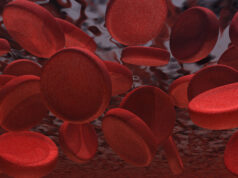
Since its introduction in the late 80s, endovascular therapy has become increasingly widespread and important. A mini-symposium held at the 2016 Charing Cross Symposium (26–29 April, London, UK), brought to the fore the radiation damage that has occurred to pioneering operators in the field. It also focused on currently available methods to reduce radiation exposure during endovascular procedures.
The list of names reads like a who’s who of pioneers in the endovascular world, and you would surely have read about and heard of these legends whose work has broken new ground, time and time again. At the CX session, Roger Greenalgh, London, UK, read out that list of names for a very different reason; he was outlining how these pioneers had personally been affected by working with ionising radiation.
First on the list was renowned cardiovascular surgeon, Edward Diethrich. After being diagnosed with cataracts in both eyes, calcified plaque in a carotid artery and a brain tumour (oligodendroglioma), he has been instrumental in taking the message of the dangers of radiation exposure to the medical community. Working in collaboration with The Organization for Occupational Radiation Safety in Interventional Fluoroscopy (ORSIF), he has released a documentary film focusing on the impact that chronic, low-level exposure to ionising radiation has on physicians that practice interventional medicine in fluoroscopy labs.
Then, Allan Reid, consultant interventional radiologist, Glasgow, UK, and a disciple of Ted Diethrich was remembered. Sadly, Reid died of a brain tumour (glioblastoma) in September 2015. His brother, Donald Reid, a consultant vascular surgeon, Edinburgh, UK, was seated in the front row.
The list of eminents went on: Krassi Ivancev, who has led the way in interventional radiology procedures in Sweden and Bulgaria and is a member of the CX Advisory Board, has been diagnosed with cataracts, as has world-class interventional radiologist Lindsay Machan from Vancouver, Canada, a frequent speaker at CX.
Greenhalgh’s presentation ended in remembering Roy Greenberg, pioneering vascular surgeon from Cleveland Clinic, USA, and a disciple of Krassi Ivancev. Greenberg is remembered as a physician who was instrumental in pushing forward the field of endografting for complex aortic disease. He died of widespread malignant tumour of the peritoneum in December 2013, aged 49.
It is important to note that when the endovascular revolution began, the dangers of working with radiation were not the first concern in physicians’ minds; they set out to help their patients using every new tool and procedure at their disposal including performing long procedures of endovascular abdominal aneurysm repair, and thoracic endovascular aortic repair. Yet, this meant that they were often putting themselves at risk in the process, and this is why, Greenhalgh emphasised, we owe these pioneers a huge debt of gratitude.
The message resonated with physicians practising in the endovascular field.
Timothy Resch, Malmo, Sweden, explained that EVAR and TEVAR are now well-established for infrarenal aortic aneurysms and descending thoracic aortic pathologies.
“Endovascular repair of areas including aortic branch vessels, such as iliac bifurcation, visceral aorta, and the aortic arch is evolving rapidly. The proper use and evaluation of preoperative imaging for planning is vital to minimise contrast and radiation exposure during complex cases. It is important that X-ray equipment and X-ray protection are properly used and understanding fundamental principles of minimising radiation exposure is critical to minimising the risk. Advanced imaging using fusion technology and intraoperative cone beam CT has the possibility of reducing exposure and improving outcome,” he said.
Reducing radiation during endovascular procedures
There is increasing awareness developing regarding occupational hazards of endovascular therapy, most importantly long-term radiation exposure, said Barry Katzen, Miami, USA.
“A number of very practical steps can be taken to reduce radiation exposure to patients, operators and staff. Awareness itself can be an effective first step in reducing exposure as operators and teams start paying attention to this important topic. Radiation reduction can be focused on reducing the amount of radiation being produced (flouroscopy dose, time, X-ray dose times and frame rates), as well as steps to provide protection to operators and staff including the use of lead aprons, eye protection, and maintaining distance. Simple methods can be surprisingly effective, such as reducing frame rates. In our institution, robotic catheterisation has been very effective at reducing dose, by both positioning operators and staff further from the source, and by reducing fluoroscopy and procedure time,” he said.
Training oneself to apply the ALARA principle
Stephan Haulon, Lille, France, then told delegates that every effort is being made to reduce radiation exposure whilst doing complex aortic endovascular reconstruction.
“Complex aortic endovascular repair procedures can be technically challenging and require fluoroscopy guidance with sometimes prolonged exposure. This has an important effect on vascular physicians, who perform these procedures each day, and are therefore at risk of exposure to high doses X-rays. However, X-rays are well-known for the biological hazards they can induce, such as skin/lenses injuries or cancer occurrence. As the benefit/risk ratio must prevail in medicine, it is mandatory to carefully evaluate the risk of radiation exposure, for the patients, but also for the medical staff—this is known as the As Low As Reasonably Achievable (ALARA) principle,” he said.
Haulon shared some tips and tricks that should be implemented in routine practice to reduce radiation exposure. For example, it is highly recommended to work with the “half or low dose modes”, available in most of the imaging systems, or to use the “pulse mode” rather than the continuous fluoroscopy. All imaging controls should be available to scrubbed physicians at the tableside. “Digital Subtraction Angiography (DSA) mode should be avoided and limited to diagnostic purposes, every time this is possible, and fluoroscopy should be preferred. Collimation must be optimised, distance between the captor and the patient minimised and distance between the tube and the patient maximised. Magnification should be avoided if not necessary, as lateral or cranio-caudal angulations.
Haulon explained that that new generation imaging systems available in the most recent hybrid rooms provide the newest technologies to successfully achieve good image quality with low exposure. “Old image intensifiers have been replaced by flat panel detectors that achieve a high level of radiographic performance. They are equipped with 3D workstations that allow a fine pre-operative analysis —useful to avoid unnecessary exposures —and advanced imaging applications, such as fusion imaging or cone beam computed tomography that also allow consequent dose savings,” he said.
“Dose awareness and training in radiation protection are also fundamental to optimise dose reduction. One should train oneself to apply the ALARA principle in daily practice by implementing all the tips and tricks to reduce exposure, but this should also be stressed during every vascular surgeon initial formation, as during its whole practice. Radiation awareness can be raised by monitoring staff occupational exposure and patients’ exposure in the operating room, and then comparing it to reference levels or published evidence. Specific attention must be paid to the application of dose reduction in routine practice to ensure safety and efficiency, for both patients and staff, during EVAR procedures,” Haulon emphasised.
Importance of simulation
Lars Loenn, Copenhagen, Denmark, made the case for radiation protection training in a simulated setting and stated that this makes a difference regarding radiation awareness. “To learn to use radiation exposure wisely, learners should be trained to undertake the task almost without thinking,” Loenn noted. This is a challenge in a classical training situation with radiation exposure to the team and patient in the angiosuite. “The simulated setting is, however, an incredible learning opportunity since it is radiation-free and allows the trainee to try different approaches and learn how to reduce the radiation exposure while receiving dynamic and instant feedback on delivered radiation in the form of a ‘heat map’. In fact, you can train on radiation aspects at the same time as you train on procedural skills in the simulator. Additionally, certain radiation safety skills needed to be obtained in specific procedure related situations can easily be created in a simulator scenario. Simulated radiation protection training could possibly even be used in credentialing new interventional operators based on a proficiency standard in the future,” he said.
“We need a new way of thinking and need to merge ergonomics, image management and radiation safety training into one package will bring essential value to training. Health professionals should be provided with the means to successfully do their jobs and I strongly believe this is the way to do it,” he said.
Key to safe application of radiation is awareness of potential risks
Fiona Rohlffs, Hamburg, Germany, then said that modern hybrid-operating rooms improve the endovascular workflow, but noted that this development is also associated with increased exposure to radiation for staff and patients. That is why it is vital, she said, that it demands more awareness of, and knowledge about dose and protective measures. Rohlffs set out that this is especially important for complex aortic procedures involving the aortic arch or the thoracoabdominal aorta.
Rohlffs and team compared reported dose values for branched or fenestrated-EVAR and present values for complex TEVAR procedures, while explaining that the comparison of dose values especially for complex procedures still remains challenging because of unequal reporting standards and acquisition system differences.
Data from the team in Hamburg showed that a comparison between fenestrated and branched EVAR shows a significant difference to the personal dose of first operator, which increased for branched procedures and seems to be due to different operating positions.
Rohllfs told delegates that dose reduction is possible if several protective measures are applied. “To achieve this, CT-fusion techniques are increasingly used for complex fenestrated or branched procedures. System improvements can significantly reduce the amount of radiation,” she noted.
Concluding, Rohllfs said that the key to safe application of radiation is the awareness of potential risks and a good knowledge of how to achieve maximal protection for patients and staff.









